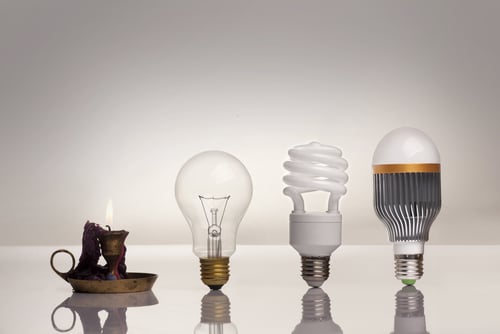What if every light bulb in the world could also transmit data? Professor Harald Haas, Chair of Mobile Communications at the University of Edinburgh and co-founder of pureLiFi, is developing a device that could do exactly that.
By flickering the light from a single LED, a change too quick for the human eye to detect, he can transmit far more data than a cellular tower — and do it in a way that's more efficient, secure and widespread. Watch Harald's TED Talk here - http://www.ted.com/talks/harald_haas_wireless_data_from_every_light_bulb
Cellular and wireless internet, or Wi-Fi, has revolutionized our connectivity to the internet and local networks, providing a cable free source of information to a multitude of devices. However, Wi-Fi comes with its limitations and weaknesses; capacity of data transmission, efficiency (in terms of power usage), the availability of transmitting devices and security issues from unauthorized wireless infiltration. Hass’ Li-Fi (light fidelity) seems to have an answer to each of these factors.
Wi-Fi technology uses radio waves to transmit data. Radio waves are relatively limited, sparse and expensive to use, in comparison to the visible light used in Li-Fi technology. This limitation of Wi-Fi is becoming increasingly problematic as we develop more connected devices and seek to download larger and larger files. Li-Fi could be a viable solution to the coming "Spectrum Crunch"; exactly when we will "hit the wall" is the subject of intense debate, but almost everyone in the industry agrees that a crunch is coming.
Standard LEDs can create a system that could both send and receive data at aggregate rates of 110 megabits per second. When transmitting in one direction only, they reached a rate of 155 Mb/s.
Members of the consortium for photonics, however, have created an LED, which provides a data rate close to 4 gigabits per second operating on just 5 milliwatts of optical output power and using high ‚Âbandwidth photodiodes at the receiver. With a simple lens to enhance the distance, they can send data 10 meters at up to 1.1 Gb/s, and soon they will increase that to 15 Gb/s, Haas says.
The 802.11ad Wi-Fi standard for the 60-gigahertz radio band reaches just under 7 Gb/s, so Li-Fi would more than double that rate.
Radio wave transmitters such as cellular masts and Wi-Fi hubs also use a relatively significant amount of power, and at very low efficiency rates. In fact, the vast majority of the power used at such terminals is used to cool the technology, rather than transmit data. Transmitting data through Li-Fi, on the other hand, requires such an insignificant amount of additional power to an active LED light, that it can be considered “free” to transmit data – as long as the light would be on for illumination reasons regardless.
When you consider this against the energy savings of LED blubs for illumination reasons, discussed in our recent report LED Lighting in Buildings 2014 to 2018 - http://memoori.com/portfolio/led-lighting-in-buildings-2014-to-2018/, you see the scale of this technology.
Availability of cellular of Wi-Fi comes down to the establishment of radio wave transmitting technology. There are, for example, about 1.5 million cellular data towers in the world. However, we have an estimated 14 billion light bulbs installed globally, if each was potentially a data transmitter, then Li-Fi stands head and shoulders above it’s radio counterparts.
“All the components, all the mechanisms exist already,” Haas says. “You just have to put them together and make them work”. Haas expects LEDs to evolve past just being light sources, much the same way the cellphone evolved from a communications device to a mobile computer.
“In 25 years, every light bulb in your house will have the processing power of your cellphone today,” he says. “It will in the future serve illumination as just one of many purposes”.
We recently published a global study on the market for Wireless Lighting Controls, which shows the huge potential for growth - http://memoori.com/portfolio/smart-buildings-wireless-lighting-controls-2014-to-2018/
The transmission of data from LED blubs are not limited to direct light, sensors can also collect data from reflected light too. A team of researchers from Fujitsu has developed an eye-opening application from this element, which they launched in Munich last month. Data rich LED bulbs were pointed at inanimate objects such as paintings, ornaments or landmarks. Then by pointing a smartphone camera at the object, users receive data on the item directly to their device - http://www.nfcworld.com/2014/12/09/333149/fujitsu-uses-led-lights-send-data-smartphones/
Set for commercial launch within 2015, the light carries the information to the device via reflection off the item in question. The technology has huge potential for use in hospitals, museums, retail and Smart Buildings. We could soon be using light to imprint digital information on an inanimate objects, and linking that to the Web, essentially creating the “Internet of Illuminated Things”.




